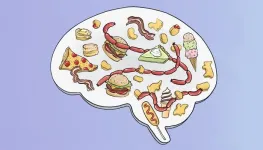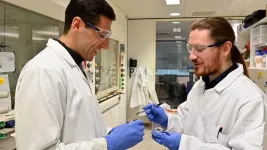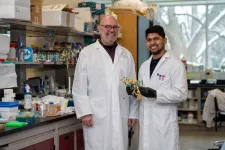(Press-News.org) The pleasure we get from eating junk food — the dopamine rush from crunching down on salty, greasy French fries and a luscious burger — is often blamed as the cause of overeating and rising obesity rates in our society.
But a new study by scientists at the University of California, Berkeley, suggests that pleasure in eating, even eating junk food, is key for maintaining a healthy weight in a society that abounds with cheap, high-fat food.
Paradoxically, anecdotal evidence suggests that people with obesity may take less pleasure in eating than those of normal weight. Brain scans of obese individuals show reduced activity in pleasure-related brain regions when presented with food, a pattern also observed in animal studies.
Now, UC Berkeley researchers have identified a possible underlying cause of this phenomenon — a decline in neurotensin, a brain peptide that interacts with the dopamine network — and a potential strategy to restore pleasure in eating in a way that helps reduce overall consumption.
The study reveals an unsuspected brain mechanism that explains why a chronic high-fat diet can reduce the desire for high-fat, sugary foods, even when these foods remain easily accessible. The researchers propose that this lack of desire in obese individuals is due to a loss of pleasure in eating caused by long-term consumption of high-calorie foods. Losing this pleasure may actually contribute to the progression of obesity.
"A natural inclination toward junk food is not inherently bad — but losing it could further exacerbate obesity," said Stephan Lammel, a UC Berkeley professor in the Department of Neuroscience and a member of the Helen Wills Neuroscience Institute.
The researchers found that this effect is driven by a reduction in neurotensin in a specific brain region that connects to the dopamine network. Importantly, they demonstrate that restoring neurotensin levels — either through dietary changes or genetic manipulations that enhance neurotensin production — can reinstate the pleasure in eating and promote weight loss.
"A high-fat diet changes the brain, leading to lower neurotensin levels, which in turn alters how we eat and respond to these foods," Lammel said. "We found a way to restore the desire for high-calorie foods, which may actually help with weight management."
While findings in mice don’t always translate directly to humans, this discovery could open new avenues for addressing obesity by restoring food-related pleasure and breaking unhealthy eating patterns.
"Imagine eating an amazing dessert at a great restaurant in Paris — you experience a burst of dopamine and happiness," said Neta Gazit Shimoni, a UC Berkeley postdoctoral fellow. "We found that this same feeling occurs in mice on a normal diet, but is missing in those on a high-fat diet. They may keep eating out of habit or boredom, rather than genuine enjoyment."
Gazit Shimoni and former UC Berkeley graduate student Amanda Tose are co-first authors, and Lammel is senior author of the study, which will be published March 26 in the journal Nature.
Solving a long-standing puzzle in obesity research
For decades, doctors and researchers have struggled to understand and treat obesity, as countless fad diets and eating regimens have failed to produce long-term results. The recent success of GLP-1 agonists like Ozempic, which curb appetite by increasing feelings of fullness, stands out among many failed approaches.
Lammel studies brain circuits, particularly the dopamine network, which plays a crucial role in reward and motivation. Dopamine is often associated with pleasure, reinforcing our desire to seek rewarding experiences, such as consuming high-calorie foods.
While raising mice on a high-fat diet, Gazit Shimoni noticed a striking paradox: While in their home cages, these mice strongly preferred high-fat chow, which contained 60% fat, over normal chow with only 4% fat, leading them to gain excessive weight. However, when they were taken out of their home cages and given free access to high-calorie treats such as butter, peanut butter, jelly or chocolate, they showed much less desire to indulge than normal-diet mice, which immediately ate everything they were offered.
"If you give a normal, regular-diet mouse the chance, they will immediately eat these foods," Gazit Shimoni said. "We only see this paradoxical attenuation of feeding motivation happening in mice on a high-fat diet."
She discovered that this effect had been reported in past studies, but no one had followed up to find out why, and how the effect connects to the obesity phenotype observed in these mice.
Restoring neurotensin reverses obesity-related brain changes
To investigate this phenomenon, Lammel and his team used optogenetics, a technique that allows scientists to control brain circuits with light. They found that in normal-diet mice, stimulating a brain circuit that connects to the dopamine network increased their desire to eat high-calorie foods, but in obese mice, the same stimulation had no effect, suggesting that something must have changed.
The reason, they discovered, was that neurotensin was reduced so much in obese mice that it prevented dopamine from triggering the usual pleasure response to high-calorie foods.
"Neurotensin is this missing link," Lammel said. "Normally, it enhances dopamine activity to drive reward and motivation. But in high-fat diet mice, neurotensin is downregulated, and they lose the strong desire to consume high-calorie foods — even when easily available."
The researchers then tested ways to restore neurotensin levels. When obese mice were switched back to a normal diet for two weeks, their neurotensin levels returned to normal, dopamine function was restored, and they regained interest in high-calorie foods.
When neurotensin levels were artificially restored using a genetic approach, the mice not only lost weight, but also showed reduced anxiety and improved mobility. Their feeding behavior also normalized, with increased motivation for high-calorie foods and a simultaneous reduction of their total food consumption in their home cages.
"Bringing back neurotensin seems to be very, very critical for preventing the loss of desire to consume high-calorie foods," Lammel said. "It doesn't make you immune to getting obese again, but it would help to control eating behavior, to bring it back to normal."
Toward more precise treatments for obesity
Although directly administering neurotensin could theoretically restore feeding motivation in obese individuals, neurotensin acts on many brain areas, raising the risk of unwanted side effects. To overcome this, the researchers used gene sequencing, a technique that allowed them to identify specific genes and molecular pathways that regulate neurotensin function in obese mice.
This discovery provides crucial molecular targets for future obesity treatments, paving the way for more precise therapies that could selectively enhance neurotensin function without broad systemic effects.
"We now have the full genetic profile of these neurons and how they change with high-fat diets," Lammel said. "The next step is to explore pathways upstream and downstream of neurotensin to find precise therapeutic targets."
Lammel and Gazit Shimoni plan to expand their research to explore neurotensin’s role beyond obesity, investigating its involvement in diabetes and eating disorders.
"The bigger question is whether these systems interact across different conditions," Gazit Shimoni said. "How does starvation affect dopamine circuits? What happens in eating disorders? These are the questions we’re looking at next."
Other co-authors are Charlotte Seng, Tamás Lukacsovich and Csaba Földy of the University of Zurich in Switzerland; Yihan Jin and Lin Tian of UC Davis; Hongbin Yang of Zhejiang University in Hangzhou, China; Jeroen Verharen, Christine Liu, Michael Tanios, Eric Hu, Jonathan Read and Lilly Tang of UC Berkeley; and Byung Kook Lim of UC San Diego.
The work was supported by the McKnight Foundation, One Mind Foundation, Weill Neurohub, Rita Allen Foundation, Wayne and Gladys Valley Foundation and National Institutes of Health (R01DA042889, U01NS120820, U01NS113295, R01NS121231, R01DA049787). Shimoni was supported by a Young Investigator Award from the National Alliance for Research on Schizophrenia and Depression.
END
Scientists discover why obesity takes away the pleasure of eating
A high-fat diet reduces a brain chemical linked to pleasure. Boosting it in mice aids weight loss.
2025-03-26
ELSE PRESS RELEASES FROM THIS DATE:
How cells respond to stress is more nuanced than previously believed
2025-03-26
CLEVELAND—The body’s cells respond to stress—toxins, mutations, starvation or other assaults—by pausing normal functions to focus on conserving energy, repairing damaged components and boosting defenses.
If the stress is manageable, cells resume normal activity; if not, they self-destruct.
Scientists have believed for decades this response happens as a linear chain of events: sensors in the cell “sound an alarm” and modify a key protein, which then changes a second protein that slows or shuts down the cell’s normal function.
But in a new study published today in the journal Nature, researchers at Case Western Reserve University have discovered a ...
A new method to recycle fluoride from long-lived PFAS chemicals
2025-03-26
UNDER EMBARGO UNTIL: 16:00 GMT / 12 NOON ET WEDNESDAY 26 MARCH 2025
A new method to recycle fluoride from long-lived PFAS chemicals
Images available via the link in the notes section.
Oxford Chemistry researchers have developed a method to destroy fluorine-containing PFAS (sometimes labelled ‘forever chemicals’) while recovering their fluorine content for future use. The results have been published today (26 March 2025) in Nature.
PFAS – which stands for poly- and perfluoroalkylated substances – have been produced in large ...
A breakthrough moment: McMaster researchers discover new class of antibiotics
2025-03-26
The last time a new class of antibiotics reached the market was nearly three decades ago — but that could soon change, thanks to a discovery by researchers at McMaster University.
A team led by renowned researcher Gerry Wright has identified a strong candidate to challenge even some of the most drug-resistant bacteria on the planet: a new molecule called lariocidin. The findings were published in the journal Nature on March 26, 2025.
The discovery of the all-new class of antibiotics responds to a critical need for new antimicrobial ...
The devastating human impact on biodiversity
2025-03-26
Humans are having a highly detrimental impact on biodiversity worldwide. Not only is the number of species declining, but the composition of species communities is also changing. These are the findings of a study by Eawag and the University of Zurich published in the scientific journal Nature. It is one of the largest studies ever conducted on this topic.
Biological diversity is under threat. More and more plant and animal species are disappearing worldwide, and humans are responsible. Until now, however, there has been no synthesis of the extent of human intervention in nature and whether the effects can be found everywhere in the world ...
Calorie-free sweeteners can disrupt the brain’s appetite signals
2025-03-26
Compared to sugar, consuming sucralose—a widely used sugar substitute—increases activity in the hypothalamus, a brain region that regulates appetite and body weight, according to a new USC study. Sucralose also changes how the hypothalamus communicates with other brain regions, including those involved in motivation. The study was just published in the journal Nature Metabolism.
About 40% of Americans regularly consume sugar substitutes, usually as a way to reduce calories or sugar intake. “But are these substances actually helpful for regulating ...
Researchers achieve quantum computing milestone, realizing certified randomness
2025-03-26
In a new paper in Nature, a team of researchers from JPMorganChase, Quantinuum, Argonne National Laboratory, Oak Ridge National Laboratory and The University of Texas at Austin describe a milestone in the field of quantum computing, with potential applications in cryptography, fairness and privacy.
Using a 56-qubit quantum computer, they have for the first time experimentally demonstrated certified randomness, a way of generating random numbers from a quantum computer and then using a classical supercomputer to prove they are truly random and freshly generated. This could pave the way towards the use of quantum computers for a practical task unattainable through ...
Lasso-shaped antibiotic co-developed by UIC evades standard drug resistance
2025-03-26
A small molecule shaped like a lasso may be a powerful tool in the fight against infectious diseases, according to a new study in Nature co-authored by University of Illinois Chicago researchers.
Lariocidin, a peptide made by bacteria living in soil, was effective against several different microbes responsible for deadly infections. UIC researchers working with collaborators at McMaster University in Canada determined how the new antibiotic works and why the drug evades bacterial resistance.
“The holy grail in the field is to find an antibiotic that binds to a new site target, has a novel mechanism of action and has ...
Two studies explore impact of pandemic on colorectal cancer screening and diagnosis
2025-03-26
INDIANAPOLIS – Two recent studies by researchers from Regenstrief Institute and the Indiana University School of Medicine explore the effect of the pandemic on colorectal cancer screening tests and diagnostic colonoscopies in Central Indiana. The findings of temporary disruption to the former and minimal impact on the latter are similar to findings across the U.S., contributing to the compendium of knowledge on preventive health uptake and subsequent treatment in various populations during the pandemic.
One study, published in PLoS One, examines both non-invasive and colonoscopy screening trends during the pandemic. The other study, ...
“Osteo-cardiovascular” patients at highest risk for falls and death, Chinese study finds
2025-03-26
A new study by researchers at Peking University and the Chinese PLA General Hospital has found that multimorbidity—living with multiple chronic diseases—is closely associated with worsening fall conditions and mortality among middle-aged and older adults in China. The findings, published in Health Data Science, identify a distinct group at especially high risk: individuals with both cardiovascular and musculoskeletal conditions, dubbed the “osteo-cardiovascular fallers.”
Falls are a major cause of injury and death in older populations globally, particularly ...
AI analysis of healthcare records reveals key factors in autism diagnosis
2025-03-26
Without clear and effective biological tests for autism based on genes, brain or blood measurements, diagnosis today still largely depends on clinical assessment. The standard way of doing this is by observing how the individual fits the criteria for autism listed in gold standard manuals like the Diagnostic and Statistical Manual of Mental Disorders, Fifth Edition (DSM-5).
These criteria are divided into two categories: one for restricted or repetitive behaviours, actions, or activities, and another for differences in social communication and interaction. In the end, however, it is the clinician, relying on years of ...
LAST 30 PRESS RELEASES:
Making lighter work of calculating fluid and heat flow
Normalizing blood sugar can halve heart attack risk
Lowering blood sugar cuts heart attack risk in people with prediabetes
Study links genetic variants to risk of blinding eye disease in premature infants
Non-opioid ‘pain sponge’ therapy halts cartilage degeneration and relieves chronic pain
AI can pick up cultural values by mimicking how kids learn
China’s ecological redlines offer fast track to 30 x 30 global conservation goal
Invisible indoor threats: emerging household contaminants and their growing risks to human health
Adding antibody treatment to chemo boosts outcomes for children with rare cancer
Germline pathogenic variants among women without a history of breast cancer
Tanning beds triple melanoma risk, potentially causing broad DNA damage
Unique bond identified as key to viral infection speed
Indoor tanning makes youthful skin much older on a genetic level
Mouse model sheds new light on the causes and potential solutions to human GI problems linked to muscular dystrophy
The Journal of Nuclear Medicine ahead-of-print tip sheet: December 12, 2025
Smarter tools for peering into the microscopic world
Applications open for funding to conduct research in the Kinsey Institute archives
Global measure underestimates the severity of food insecurity
Child survivors of critical illness are missing out on timely follow up care
Risk-based vs annual breast cancer screening / the WISDOM randomized clinical trial
University of Toronto launches Electric Vehicle Innovation Ontario to accelerate advanced EV technologies and build Canada’s innovation advantage
Early relapse predicts poor outcomes in aggressive blood cancer
American College of Lifestyle Medicine applauds two CMS models aligned with lifestyle medicine practice and reimbursement
Clinical trial finds cannabis use not a barrier to quitting nicotine vaping
Supplemental nutrition assistance program policies and food insecurity
Switching immune cells to “night mode” could limit damage after a heart attack, study suggests
URI-based Global RIghts Project report spotlights continued troubling trends in worldwide inhumane treatment
Neutrophils are less aggressive at night, explaining why nighttime heart attacks cause less damage than daytime events
Menopausal hormone therapy may not pose breast cancer risk for women with BRCA mutations
Mobile health tool may improve quality of life for adolescent and young adult breast cancer survivors
[Press-News.org] Scientists discover why obesity takes away the pleasure of eatingA high-fat diet reduces a brain chemical linked to pleasure. Boosting it in mice aids weight loss.







